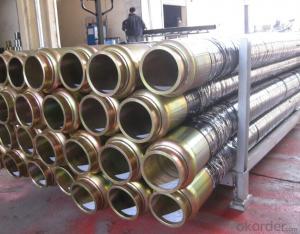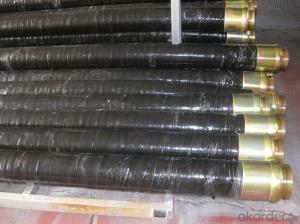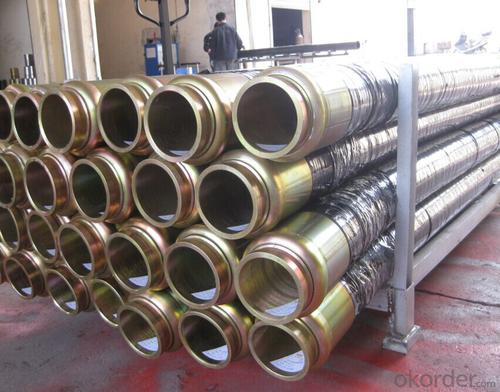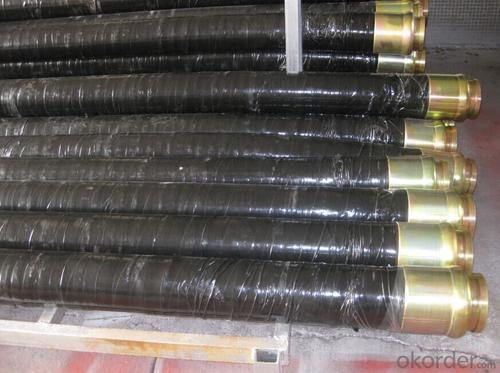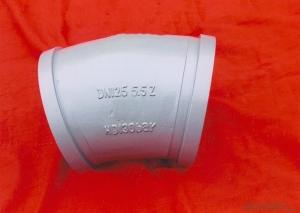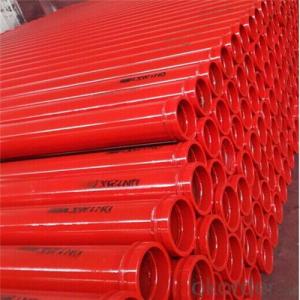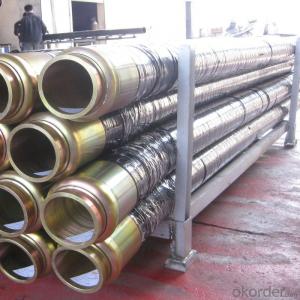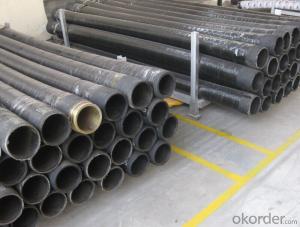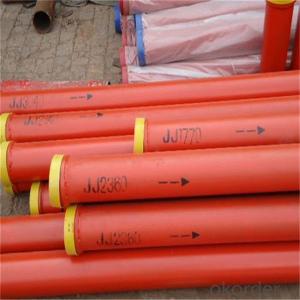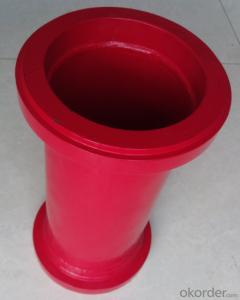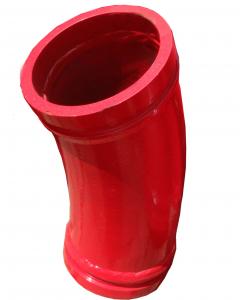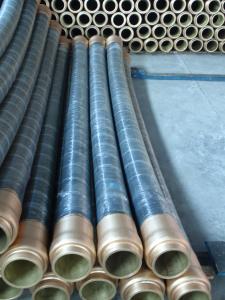Rubber End Hose With Two Side Couplings Working Pressure 85 Bar 6M*DN150
- Loading Port:
- Shanghai
- Payment Terms:
- TT OR LC
- Min Order Qty:
- 10 pc
- Supply Capability:
- 5000 pc/month
OKorder Service Pledge
OKorder Financial Service
You Might Also Like
Product Description:
The 6M*DN150 rubber end hose with two side couplings, normally the hoes is made by NR and reinforced by four layer steel wire, and the two couplings at each side are made by steel material No.ST52, 20#, 37MN5, with hot treatment according to customer’s requests, and also package in bundles or nude packing directly put into container.
Scope of Application of the hose
This end hose can only be used in concrete construction operations, but not in any other operations, like dragging, moving, or hoisting heavy articles or personnel. The end hose is also not allowed to be used in any location where any combustible or explosive material exists or a cave-in may occur.
Our end hoses have very good feedbacks from old customers, it can be used conected togeather one by one by clamps for a long line concrete delivery in same time.
Product Advantages:
OKorder's 6M*DN150 rubber end hose Channels are durable, strong, and safety. We are the biggest group in this business filed and the majority resources are under our control, which is make sure the delivery time and qualified products, meanwhile we have more than 20 overseas branches our people will go to visit customer very fast for more convenient communication.
Main Product Features:
· Premium quality
· Prompt delivery & seaworthy packing (5-10 days)
Reliable performance
FAQ:
Q1: How long about delivery time?
A1: Normally we keep the raw materials for old customers and sometime we also keep stock products to make sure delivery time in any emergency cases.
Q2: How do we guarantee the quality of our products?
A2: We have established an advanced quality management system which conducts strict quality tests at every step, from raw materials to the final product. At the same time, we provide extensive follow-up service assurances as required.
Q3: How soon can we receive the product after purchase?
A3: Within three days of placing an order, we will book the vessel for goods. The specific shipping date is dependent upon international and government factors, but is typically 7 to 30 workdays.
Q4: If we can produce some pipes according to customers request?
Name | Concrete Pump Rubber Hose | |||||
Size | ID | OD | Number of layer | Work pressure | bursting pressure | weight |
3.5" | 113 | 2 | 1200psl | 3000psl | 6.8kg/m | |
4" | 128 | 2 | 1200psl | 3000psl | 7.8kg/m | |
5" | 154 | 2 | 1200psl | 3000psl | 10kg/m | |
5" | 154 | 4 | 1200psl | 3000psl | 12kg/m | |
6" | 181 | 2 | 1200psl | 3000psl | 15kg/m | |
Other size and types upon request | ||||||
Usual Size | 4"-DN80, 5" -DN125, 6"-DN150 | |||||
Material | natrual rubber,steel wire | |||||
Technic | steel wire weaving,composite molding | |||||
Application | used in concrete transport of concrete pump end in construction work | |||||
Serving Brands Of Mounted Truck Concrete Pump And Concrete Pump | SANY,Zoomlion,PM,CIFA and so on | |||||
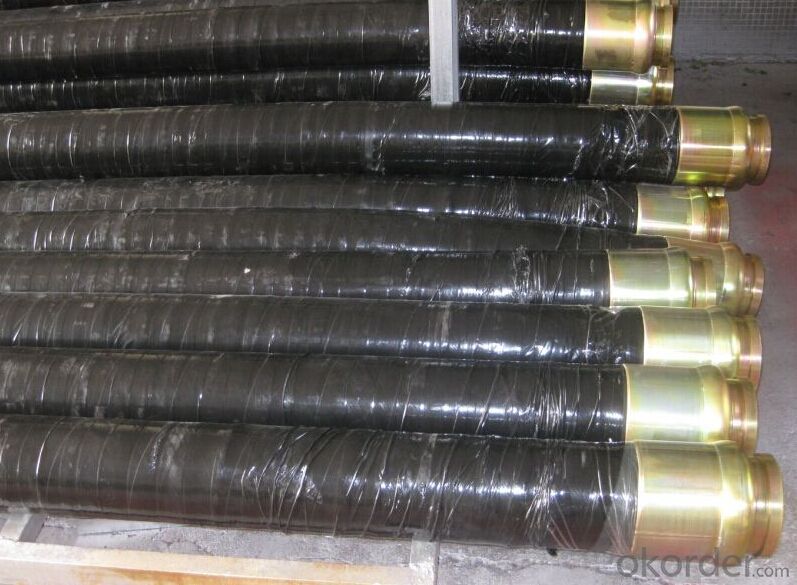
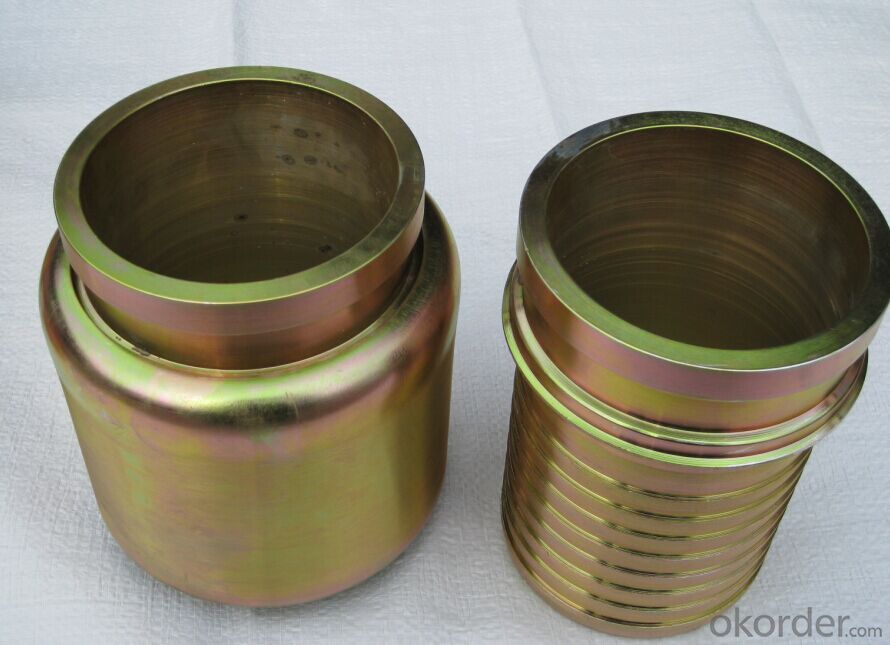
- Q: Are there any specific guidelines for the installation of pistons or cylinders in concrete pump spare parts?
- Yes, there are specific guidelines for the installation of pistons or cylinders in concrete pump spare parts. It is important to follow manufacturer instructions and recommendations for proper alignment, lubrication, and torque specifications during installation. Additionally, regular inspection and maintenance are crucial to ensure optimal performance and longevity of the pump parts.
- Q: How can one extend the lifespan of concrete pump spare parts?
- There are several measures that can be taken to extend the lifespan of concrete pump spare parts: 1. Maintenance should be performed regularly. This includes cleaning, lubricating, and inspecting the parts for signs of wear or damage. By addressing any issues early on, further damage can be prevented and the lifespan of the parts can be prolonged. 2. Proper storage is important. When not in use, the spare parts should be stored in a clean and dry environment. Exposure to moisture, dust, and other contaminants can cause corrosion and deterioration of the parts. Storing them in a designated area with appropriate protection can help prevent these issues. 3. Investing in high-quality spare parts can greatly impact their lifespan. Choosing reputable brands and manufacturers that produce durable and reliable parts can ensure their longevity. Despite the initial higher cost, they will save money in the long run as they will require less frequent replacement. 4. Following the manufacturer's guidelines and instructions for the concrete pump spare parts is crucial. Overloading or operating the equipment improperly can put excessive strain on the parts, resulting in premature wear and tear. Using the parts within their recommended capacity and following proper operating procedures will help extend their lifespan. 5. Proper training and supervision of operators and maintenance personnel is essential. Educating them on best practices, proper handling, and maintenance techniques will prevent misuse or mishandling that can damage the parts. 6. Regular inspections should be conducted to identify potential issues early on. This includes checking for signs of wear, damage, or misalignment. By addressing these issues promptly, further damage can be prevented and the lifespan of the parts can be extended. By implementing these measures, the lifespan of concrete pump spare parts can be significantly extended, resulting in reduced downtime and improved efficiency in construction projects.
- Q: What are the different types of concrete pump hopper cylinders?
- There are primarily two types of concrete pump hopper cylinders: single-acting cylinders and double-acting cylinders. Single-acting cylinders have only one piston that pushes the concrete out of the hopper. On the other hand, double-acting cylinders have two pistons, one for pushing the concrete out and the other for bringing it back into the hopper.
- Q: How can one determine the correct size and dimensions of concrete pump spare parts?
- To determine the correct size and dimensions of concrete pump spare parts, there are several important steps to follow: 1. Identify the specific make and model of your concrete pump: Each concrete pump has its own unique specifications and requirements for spare parts. Therefore, it is crucial to know the make and model of your pump before ordering any spare parts. 2. Consult the manufacturer's documentation: Manufacturers often provide detailed documentation that includes information on the required size and dimensions of spare parts. This documentation may include technical drawings, diagrams, and part numbers that can help you find the correct size. 3. Measure the existing spare part: If you already have a spare part that needs replacement, you can measure its size and dimensions using precision tools like calipers or a measuring tape. Take accurate measurements of key dimensions such as length, width, height, and any other relevant specifications. 4. Seek professional assistance: If you are unsure about the correct size and dimensions, it is advisable to consult with a professional or an authorized dealer. They have expertise in concrete pumps and can guide you in selecting the right spare parts based on your pump's specifications. 5. Consider compatibility and quality: When purchasing spare parts, ensure they are compatible with your concrete pump's make and model. Additionally, prioritize quality to ensure longevity and optimal performance. Buying from reputable suppliers or directly from the manufacturer can help ensure the spare parts meet the necessary size, dimensions, and quality standards. By following these steps, you can accurately determine the correct size and dimensions of concrete pump spare parts, ensuring smooth operation and minimizing downtime.
- Q: How long does it take to receive concrete pump spare parts after placing an order?
- The time it takes to receive concrete pump spare parts after placing an order can vary depending on several factors. Firstly, it depends on the availability of the specific spare parts you have ordered. If the parts are readily available in stock, the delivery time can be relatively quick. However, if the parts are not in stock and need to be manufactured or sourced, it may take longer to receive them. Secondly, the location and distance between the supplier and your location also play a role in the delivery time. If the supplier is in close proximity, the parts can be delivered within a few days. However, if the supplier is located far away or in a different country, it may take longer due to shipping and customs processes. Furthermore, the shipping method you choose can also impact the delivery time. Expedited shipping options can ensure quicker delivery, but at an additional cost. Standard shipping methods may take longer but are usually more cost-effective. Lastly, the efficiency and responsiveness of the supplier also come into play. A reliable supplier with a streamlined ordering and shipping process will likely be able to deliver the spare parts in a shorter time frame. In conclusion, the time it takes to receive concrete pump spare parts after placing an order can vary based on factors such as availability, location, shipping method, and supplier efficiency. It is advisable to inquire about estimated delivery times when placing the order to have a better understanding of when the parts will be delivered.
- Q: What is the purpose of a concrete pump cleaning ball?
- The purpose of a concrete pump cleaning ball is to effectively clean and remove any residual concrete or debris that may be left inside a concrete pump system. These cleaning balls are designed to be inserted into the pumping system and then pushed through the pipes using water pressure or compressed air. As they move through the system, the cleaning balls scrape off any hardened concrete or buildup, ensuring that the pump and pipes remain free from blockages and perform at their optimal level. This regular cleaning process helps to prevent clogs, maintain the efficiency of the pump, and prolong the lifespan of the equipment. Additionally, using cleaning balls also helps to ensure that the next batch of concrete being pumped is not contaminated by any leftover debris, resulting in a higher quality end product.
- Q: Can I get spare parts for concrete pump boom arms and pipes?
- Yes, you can definitely get spare parts for concrete pump boom arms and pipes. There are various suppliers and manufacturers that specialize in providing spare parts for concrete pumps. These spare parts include boom arms, pipes, couplings, gaskets, seals, and other components that are necessary for the proper functioning of a concrete pump. You can search for these spare parts online, where you will find numerous websites and online stores that offer a wide range of options. It is important to ensure that you purchase spare parts from reputable suppliers to ensure their quality and compatibility with your specific concrete pump model. Additionally, there are also local dealers and distributors who stock spare parts for concrete pumps. You can inquire with them or visit their stores to find the required spare parts for your boom arms and pipes. Regular maintenance and replacement of worn-out or damaged parts is crucial for the efficient and safe operation of a concrete pump. By investing in high-quality spare parts, you can extend the lifespan of your equipment and ensure its optimal performance.
- Q: How long do concrete pump hoses typically last?
- Concrete pump hoses typically last between 3 to 5 years, depending on factors such as usage frequency, maintenance, and the type of material being pumped.
- Q: How does the concrete pump work?
- When the pump is in place, support the leg and keep the body level and stable. When feeding with a distributor, the body shall not exceed 3 degrees of inclination
- Q: What are the advantages of using OEM (Original Equipment Manufacturer) concrete pump spare parts?
- There are several advantages of using OEM concrete pump spare parts. Firstly, OEM parts are specifically designed and manufactured by the original equipment manufacturer, ensuring a perfect fit and compatibility with your concrete pump. This results in optimal performance and efficiency, minimizing downtime and costly repairs. Secondly, OEM parts are made from high-quality materials, meeting strict industry standards and specifications. This guarantees durability and longevity, reducing the need for frequent replacements. Additionally, OEM parts often come with warranties, providing peace of mind and protection against any manufacturing defects. Lastly, using OEM parts ensures the preservation of your concrete pump's warranty and resale value. Overall, opting for OEM concrete pump spare parts ensures reliability, performance, and cost-effectiveness in the long run.
Send your message to us
Rubber End Hose With Two Side Couplings Working Pressure 85 Bar 6M*DN150
- Loading Port:
- Shanghai
- Payment Terms:
- TT OR LC
- Min Order Qty:
- 10 pc
- Supply Capability:
- 5000 pc/month
OKorder Service Pledge
OKorder Financial Service
Similar products
Hot products
Hot Searches
Related keywords
